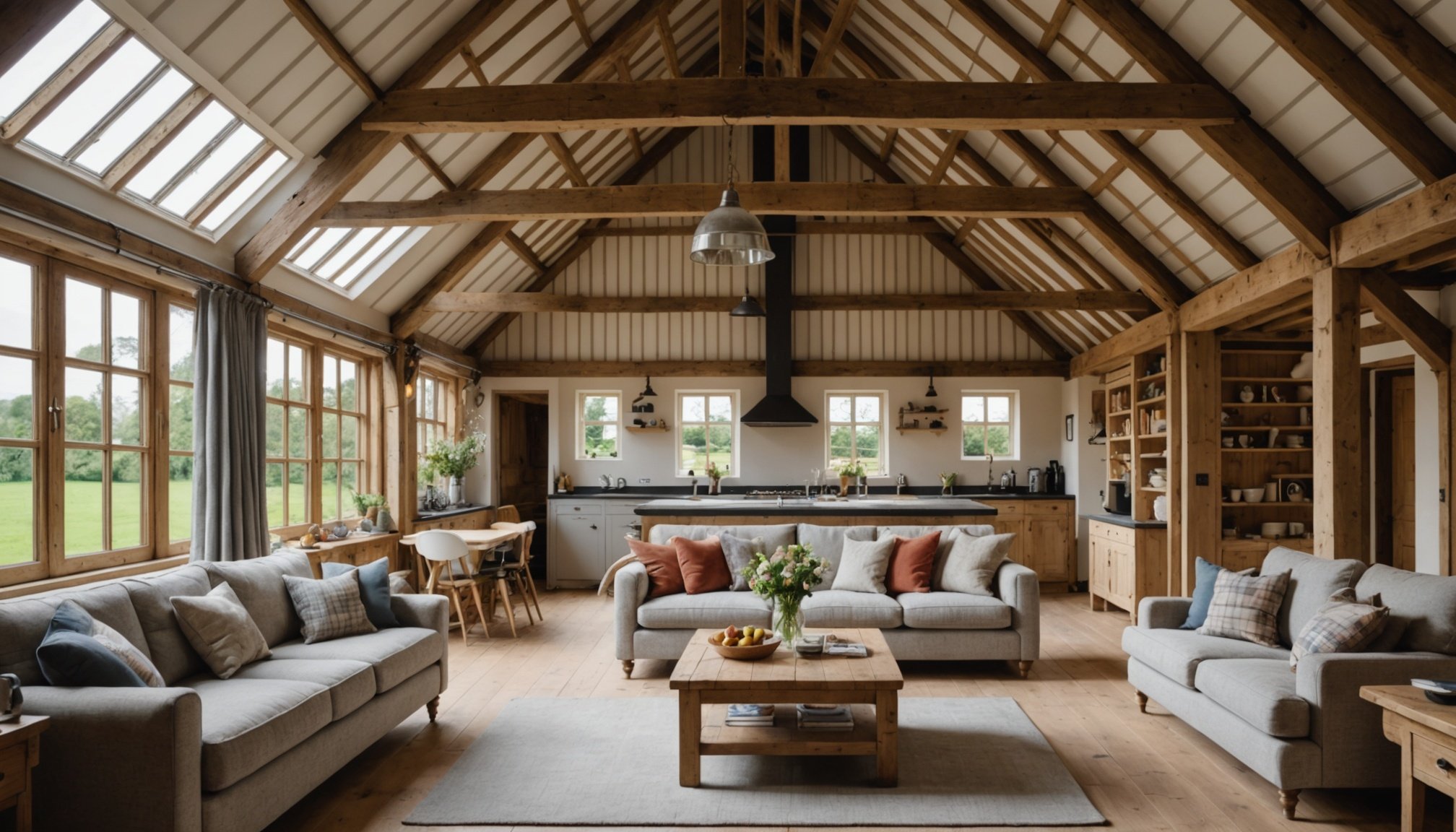Understanding Building Regulations for Barn Conversions
Transforming a barn into a home is an exciting venture, but it requires careful attention to building regulations. These guidelines ensure that the conversion meets safety and environmental standards. In the UK, understanding and adhering to these barn conversion laws is crucial.
Before beginning a barn conversion, one must acquire necessary permits, including planning permission and compliance with building regulations. This process ensures that all structural changes adhere to safety standards. Obtaining approval might involve detailed plans for insulation, plumbing, and electric systems, among other aspects.
Also to discover : Unlocking Historical Preservation Funds: A Guide to Assessing UK Property Eligibility and the Application Process
Adhering to current UK standards is paramount. These standards encompass everything from energy efficiency to structural integrity. By ensuring compliance, owners can avoid costly remodels or fines. Moreover, compliant properties tend to have higher market values and can be sold more easily, if desired.
Non-compliance with legal requirements can lead to severe consequences. These range from financial penalties to legal actions, not to mention the potential safety risks posed by an unregulated building. It’s essential to consult professionals, such as architects or planners, who can guide through the regulations and help navigate the complexity of the laws. Understanding and adhering to these laws will ensure a successful and legally sound barn conversion.
In parallel : Unlocking Historical Preservation Funds: A Guide to Assessing UK Property Eligibility and the Application Process
Planning Your Barn Conversion
When diving into barn conversion planning, the first step is to assess the structural integrity of the barn. This crucial step ensures the barn can safely accommodate future design elements. Start by inspecting the foundation for any cracks or issues, and assess the roof’s condition. Engaging a professional engineer can help identify hidden structural challenges and propose necessary reinforcements.
Creating a design that balances aesthetics and functionality goes hand-in-hand with ensuring structural soundness. A well-thought-out design considers both the rustic charm of the barn and contemporary living needs. Consider how natural light can be maximised through existing openings and whether additional windows or skylights may be required. Think about how spaces can be adapted for modern use without sacrificing their authentic character.
Budgeting is an integral part of the barn conversion process. Start by setting a realistic budget, taking into account costs for structural repairs, materials, labour, and unexpected expenses. It’s important to allocate funds for design features that enhance both beauty and practicality. Divide your budget into major categories to efficiently monitor spending.
By covering these essential planning aspects, you position your project on the path to success while ensuring an efficient and aesthetically pleasing outcome.
Step-by-Step Conversion Process
Transforming a barn into a functional space requires a well-structured approach. Here’s a breakdown of the key barn renovation steps.
Initial Assessment and Design
At the heart of every successful conversion process is a detailed initial assessment. Begin by evaluating the existing structures and features of the barn. This not only identifies the strengths and limitations of the building but also informs the design stage. During design, consider modern needs while respecting the barn’s original charm.
Obtaining Necessary Permits
Before commencing any physical work, securing the appropriate permits is crucial. This step ensures that the conversion aligns with local regulations and zoning laws. The process might be time-consuming, but it safeguards against potential legal complications.
Construction Techniques and Materials
Select construction techniques and materials that enhance both functionality and efficiency. Opt for environmentally friendly materials to promote energy efficiency, such as insulated panels for temperature control. Factor in the renovation timeline when planning; allowing for unforeseen delays is wise. By adhering to these structured steps, the barn conversion not only meets practical needs but also embodies sustainable and aesthetically pleasing design principles.
Interior Design Ideas for Comfort
Creating a cozy living space in a barn conversion involves thoughtful integration of style and functionality. Start by selecting an interior design that complements the barn’s rustic architecture. Embracing the barn’s inherent charm can result in an inviting ambiance that resonates with its traditional elements. Consider using natural wood finishes, exposed beams, and earthy tones to accentuate the characteristic features of the space.
Space optimization is crucial, especially in smaller barn homes. Implement strategies that maintain an open feel while ensuring practicality. Furniture with multiple uses, such as sofas that double as beds or tables with built-in storage, can maximize utility without cluttering the environment.
Incorporating sustainable and eco-friendly design principles is also essential for a modern barn conversion. Opt for eco-conscious materials like reclaimed wood, recycled metal, or bamboo, which add a unique touch and adhere to sustainable practices. Moreover, energy-efficient lighting and solar panels can reduce environmental impact and harness natural resources effectively.
By following these tips, a barn can transform into a comfortable and sustainable haven. Balancing aesthetic appeal with functionality creates living spaces that are not only cozy but also respect their architectural roots.
Budgeting and Cost Management
When planning a barn conversion, estimating costs for construction and materials is crucial to the success of the project. Begin by obtaining detailed quotes from contractors and suppliers, enabling you to get a clear picture of what the financial outlay might be. Consider not only the basic structural alterations but also the costs of interior fittings, utilities, and permits.
It’s essential to include contingency planning for unexpected expenses. Unforeseen challenges such as structural surprises or issues with old electrical systems may arise. A general rule of thumb is to allocate about 10-20% of your budget to cover these contingencies. This helps prevent financial strain and ensures your project can continue smoothly even if surprises occur.
Budgeting for renovations shouldn’t stop at initial costs; consider how you will finance the transformation. Various options are available, including personal loans, mortgages tailored for property renovations, or even government grants designed for heritage building repairs. Comparatively, these options can impact your long-term budget, so choose the finance source that aligns with your long-term financial goals.
By managing costs rigorously throughout your barn conversion, you can bring your vision to life without undue financial hardship. Consider working with financial advisors for optimal cost management strategies.
Finding Reliable Contractors and Resources
Embarking on a barn conversion is an exciting journey, but finding contractors for barn conversion that meet your needs is crucial to success.
Selecting the Right Contractor
When selecting contractors, it’s essential to evaluate their experience, especially in barn conversions. Review their portfolio for past projects that resonate with your vision. Pay attention to their approach in handling structural challenges. Personal recommendations and testimonials from previous clients can also provide valuable insight.
Recommended Suppliers and Materials
Choosing the right materials is pivotal for renovation. Opt for key materials suppliers who specialise in barn conversions to ensure quality and durability. Suppliers with a range of traditional and modern materials can help maintain aesthetic integrity. Using reclaimed materials can add character and may reduce costs. Selecting a supplier with excellent customer service can streamline your procurement process.
Utilizing Online Resources and Checklists
The digital age provides many renovation resources to guide you in planning and budgeting. Online checklists can help keep track of tasks and deadlines, ensuring a smooth process. Budget calculators tailored for barn conversions can assist in financial planning. Furthermore, forums and communities centered around barn conversions often have insightful tips and feedback from experienced renovators.
Post-Completion Considerations
Once your barn home renovation is complete, the journey of maintaining and enhancing your unique space begins. Adopting the right maintenance tips ensures your home stays in top condition and continues to be energy efficient.
When it comes to barn home upkeep, long-term maintenance plays a crucial role. Regularly inspecting the structural integrity of wooden beams and roofing can prevent costly repairs in the future. Additionally, weatherproofing measures, such as sealing drafts and proper insulation, are vital for maintaining energy efficiency, which not only helps the environment but also reduces utility bills.
The key to maintaining energy efficiency post-renovation lies in consistent monitoring and upgrades. Investing in energy-efficient appliances and considering renewable energy sources, like solar panels, can further enhance your home’s sustainability. These changes, while initially costly, can lead to substantial savings over time.
An often-overlooked aspect of barn home upkeep is community resources. Engaging with local groups or online forums dedicated to barn home enthusiasts can provide valuable advice and support. These communities are treasure troves of information, offering tips that cater specifically to the unique maintenance challenges of barn homes. Being active in such communities not only helps you stay informed but also opens doors to new ideas and trends in barn home living.












